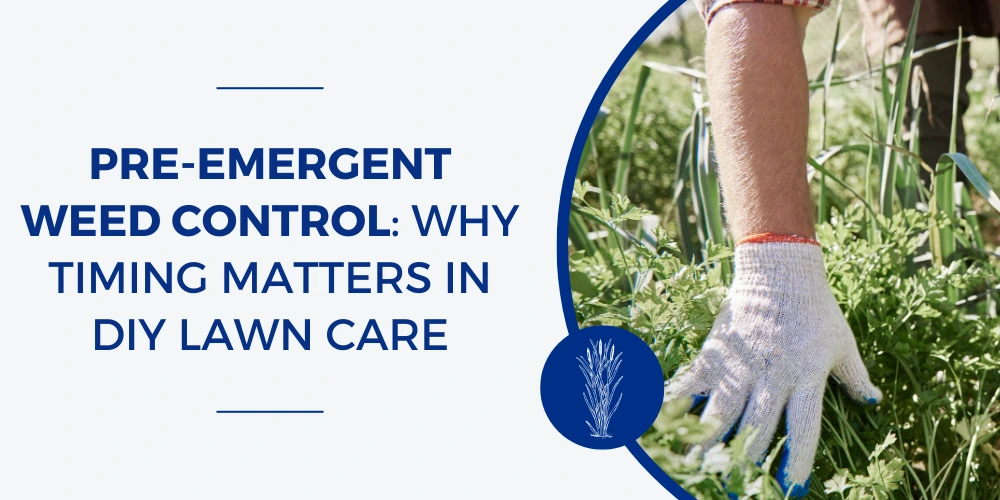It takes effort to maintain a healthy lawn free of weeds. What lawn care experts sometimes keep to themselves? Treatment is less successful than prevention. The foundation of proactive lawn maintenance that can spare you many hours of picking weeds over the growth season is pre-emergent weed control.
This book defines pre-emergents, describes their operation, and most importantly, why proper timing is crucial for successful DIY lawn pest control in Arizona.
What Is Pre-Emergent Weed Control?
Pre-emergent herbicides form an unseen barrier in the soil, blocking the successful germination and root establishment of weed seeds. Unlike post-emergent therapies that kill current weeds, pre-emergents operate by preventing weeds before they even penetrate the soil surface.
These particular pesticides go after typical lawn pests such as:
- Crabgrass
- Annual bluegrass
- Foxtail
- Chickweed
- Henbit
- Spurge
The beauty of pre-emergent weed control is that it works silently underground, preventing weed problems rather than solving them after they've already damaged your lawn's appearance.
Why Timing Matters More Than You Think
Proper timing nearly totally determines the efficacy of pre-emergent herbicides. Apply too early, and the product can deteriorate before weeds start sprouting. Apply too late, and the pre-emergent will be worthless as weeds will have already established themselves.
Pre-emergents have to be applied before weed seeds germinate, not after weeds become evident. Soil temperature and seasonal fluctuations, not calendar dates, decide this time.
In Arizona's particular environment, this usually implies that requests should take place:
- For summer annual weeds like crabgrass, early spring, February to March, is best.
- Winter annual weeds like annual bluegrass should be planted early in August to September.
This timetable changes depending on the area and weather trends; so, DIY weed control success depends on knowledge of your local circumstances.
How to Know When to Apply Pre-Emergent in Arizona
Successful pre-emergent application depends on environmental clues rather than mindlessly following calendar dates.
- Watch soil temperature: summer annual weed seeds start germinating when soil consistently hits 55°F (12°C) at a 2-inch depth. Winter annuals are triggered when soil temperatures drop below 70°F.
- Make use of nearby resources: Arizona Cooperative Extension offices usually offer forecasts of weed emergence and soil temperature tracking, particular to your area.
- Look for natural signs: Early flowering plants like forsythia can suggest when soil temperatures are right for the first spring treatment.
- Think about past weather trends: a succession of warm days after rain offers perfect germination conditions, therefore indicating the time to apply.
Many DIY lawn lovers buy a cheap soil thermometer to take the guesswork out of this vital timing decision.
How to Apply Pre-Emergent Weed Control Properly
To apply pre-emergent effectively, follow these guidelines:
- Prepare your lawn: Mow at a consistent height and water the lawn 1-2 days prior to application to guarantee the substance gets to the soil surface.
- Pick the correct product: Choose a pre-emergent herbicide marked for the particular weeds you are aiming at. For do-it-yourself uses, granular materials are effective.
- Apply evenly: For liquid formulations, use a pump sprayer; for granular goods, use a broadcast or drop spreader. Application rates should follow the package directions.
- Water it in: After application, water gently (approximately ¼ inch) to activate the herbicide and generate the protective barrier in the soil.
- Let it settle: Avoid disturbing the soil surface for at least 1-2 weeks after application, as this can damage the protective barrier.
- Keep appropriate coverage: Depending on the product's persistence, a second treatment can be required after 8-10 weeks for season-long protection.
Pre-emergent herbicides won't kill current weeds, so remove any visible ones before spraying for the best results.
Mistakes to Avoid with Pre-Emergent Herbicides
Even experienced DIY lawn care enthusiasts can make these common mistakes:
- Applying too late - Once you see weeds emerging, pre-emergents won't help. At that point, you'll need post-emergent treatments.
- Expecting immediate results - Pre-emergents work invisibly by preventing germination, not killing existing plants.
- Disturbing the barrier - Aerating, dethatching, or excessive raking after application can break the protective barrier.
- Applying before seeding - Most pre-emergents will prevent your grass seed from germinating, too. If you're planning to seed, timing becomes even more critical.
- Overlooking label instructions - Application rates, watering requirements, and reapplication intervals vary by product.
- Using the wrong formulation - Some pre-emergents target grassy weeds while others target broadleaf weeds. Know your enemy before selecting your weapon.
Benefits of Using Pre-Emergent in a DIY Lawn Care Routine
Incorporating pre-emergent herbicides into your seasonal lawn care routine offers numerous advantages:
- Dramatic reduction in weed pressure - Preventing weeds is far more efficient than fighting established ones.
- Time and labor savings - Spend less time pulling weeds and more time enjoying your outdoor space.
- Improved lawn density - With less competition from weeds, desirable grasses can grow thicker and healthier.
- Reduced need for post-emergent herbicides - Fewer established weeds mean less need for potentially harsher weed killers.
- Long-lasting protection - A properly timed application can provide months of protection, creating a solid foundation for your entire lawn care program.
- Cost effectiveness - Pre-emergent treatment costs less than repeatedly treating widespread weed infestations.
Conclusion
Creating a weed-free lawn with the least effort with pre-emergent weed management is the hidden weapon. Arizona residents can have significantly better outcomes from their DIY lawn care efforts by knowing the vital need of timing, choosing the appropriate supplies, and using them properly.
Keep in mind that in weed control, the ancient saying holds: an ounce of prevention is worth a pound of cure. Invest in pre-emergent herbicides at the appropriate moment, and your grass will be healthier, more lovely all season long.

